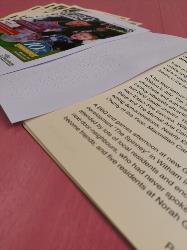All news

Which Accessible Format Should You Choose?
March 20, 2019
There are many accessible formats which
can be produced, including braille, large print, Easy Read, audio files (audiotape, digital audio files, for example MP3 format,
CD), DAISY and accessible electronic formats.
For
many purchasers, deciding which accessible formats to produce or offer can be
difficult. Everyone wants to be able to
provide a good service to people who are print impaired and perhaps in an ideal
world every document would be available in any accessible format, but this is
impractical for many reasons, not least of which is cost. The truth is that there are several factors
to consider and making good choices will help the end-user, while keeping the
overall cost down:
The
target audience – if the target group is young people for example, a
well-constructed accessible electronic format may be sufficient. As is
true for the rest of the population, young visually impaired people are
the most likely to be technologically adept!
Length
of document – some formats lend themselves better to shorter documents.
Braille, for example, takes up four times as much space as standard print
and can be very cumbersome for longer documents.Use of
the document – is the document intended to be used once or kept for reference?
Reference documents need to be more robust than single-use documents and
need to be easy to navigate. DAISY (Digital Accessible Information SYstem)
is a good accessible format and technical standard for reference documents.
Location
– will the recipient be accessing the information at home or away from
home? If documents need to be taken to and accessed at a meeting for
example, size and access method are important. Furthermore, if directions
to the venue are included, will the format be accessible while on the
move
Individual
preferences – If you will regularly be producing an accessible format for
a specific individual it's worth finding out their preferences. However, it’s worth noting that this may
vary depending on the type of correspondence: braille for letters or statements and
audio/electronic for lengthy reports, for example.
Timescale
– If something is time sensitive, hopefully you will have been able to
plan your accessible formats to get them out with the standard print, but
where this is not possible you will have to consider what can
realistically be done within your timescale.
Remember that you can make “alternative formats
available on request” rather than automatically producing them, however this
offer of additional formats must be stated clearly in large print on the document,
and if you do get requests you have to be prepared to meet your obligations in
an effective and timely manner.










